-
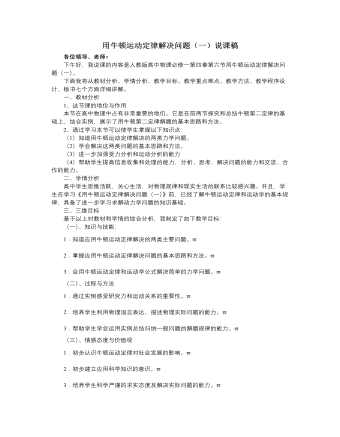
人教版新课标高中物理必修1用牛顿运动定律解决问题(一)说课稿
六、教学程序设计(“一三五”模式)为了完成这节课的教学目标,我是这样安排的:第一环节: (约10分钟)根据对自主探究案的批阅情况,解决学生的遗留问题具体实施:投影学生的自主探究案,让学生交流讨论,教师点评。第二环节: ( 约30分钟)新课学习:在“课堂互动案”的导学提纲引领下,完成这节课的三维教学目标。具体实施:多媒体辅助教学、交流讨论。第三环节: (约5分钟)课堂小结和布置作业:为了体现课程改革的新理念——学生是学习的主人,我改变传统的教师总结为学生总结的模式,既强化了学生所学的知识,又培养了学生的归纳和概括能力。作业分为两部分:(1)书面作业p85,1、2、3、4。(2)完成“应用提升案”。七、板书设计由于多媒体在物理教学中仅是一种辅助手段,不能完全取代黑板,因此一节课的主要内容和学生的必要参与还需要借助黑板来帮助。我在这节课的板书设计中突出了主要内容,简洁明了。

人教版新课标高中物理必修2验证机械能守恒定律说课稿
一、 教材分析与学情分析教材分析人民教育出版社普通高中课程标准实验教科书必修2第七章第九节。本节内容安排在学习机械能守恒定律之后的目的,是为了使学生在理论上对机械能守恒定律有所了解的基础上,通过实验测量及对实验数据的分析处理,对机械能守恒定律及条件有深刻的认识。学情分析知识层面:学生已经掌握了动能、重力势能等概念以及动能定理、机械能守恒定律等定理、定律;知道功是能量转换的量度以及机械能守恒的条件。能力层面:学生已具备一定的实验操作技能,会用打点计时器以及直尺等实验仪器。具备一定的数据处理能力。二、教学目标与重点、难点教学目标知识与技能:1、会用打点计时器打下的纸带计算物体运动的速度。2、掌握验证机械能守恒定律的实验原理。
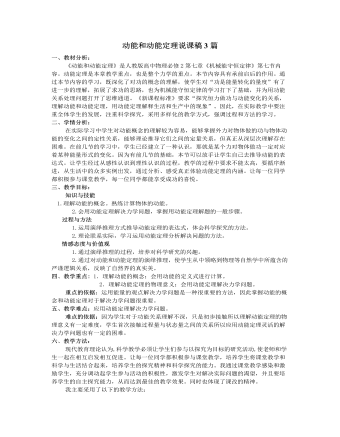
人教版新课标高中物理必修2动能和动能定理说课稿3篇
2、教学目标根据我对教材的理解、结合学生的实际情况、渗透新课程的教学理念,为提高全体学生的科学素养,按课程标准,以促进全体学生发展为目的。从知识与技能、过程与方法,情感态度与价值观三个方向培养学生,拟定三个教学目标:知识与技能:(1)知道什么是动能。(2)正确理解和运用动能公式分析、解答有关问题。(3)掌握外力对物体所做的总功的计算,理解“代数和”的含义。(4)理解和运用动能定理。过程与方法:通过演绎推理过程,培养科学研究兴趣,领略物理学中所蕴含的严谨的逻辑关系。情感、态度、价值观:通过运用动能定理分析解决问题,感受成功的喜悦,培养学生对科学研究的兴趣。3、教学的重点和难点重点:理解动能定理、应用动能定理解决力学问题。难点:应用动能定理解决多个过程的力学问题,以及变力做功或曲线运动中的动能定理运用。
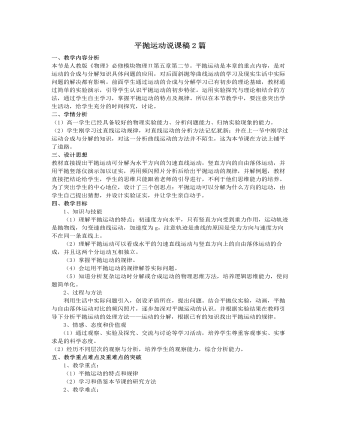
人教版新课标高中物理必修2平抛运动说课稿2篇
(5)高度不同,对平抛运动距离有何影响,是否因为高度减小后下落时间减小,所以要增大速度才能达到相同的距离?(教学实践证明,这种想法在学生比较多见。已经不自觉的沿用了自由落体运动的规律,又隐隐有运动等时性的痕迹。应引导学生这一结果还需实验验证。)教师的引导:其实,我们所提出的看法都跟平抛运动的规律有关系。那么平抛运动究竟有怎样的规律呢?以前学过的直线运动知识还能用于今天的内容吗?由此逐步使学生意识到分析平抛运动须采用运动合成与分解这一方法。三、实验验证自主探究(15分钟) 物理是实验科学,多媒体教学不能代替实验。本教学设计的第三个环节是实验验证,鼓励学生自主探究。引导学生根据自己的猜想(实验目的)设计实验进行验证。(1)介绍手持式平抛竖落仪,引导并小结实验要领:听两小球下落声音判断其下落时间。体会合运动和分运动是等时的。
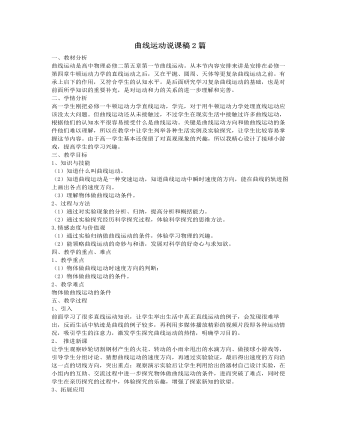
人教版新课标高中物理必修2曲线运动说课稿2篇
1、举例:2、结论:(1)物体的运动轨迹是曲线的运动叫曲线运动。(2)曲线运动中速度方向是时刻改变的。(二)、曲线运动方向:1、质点在某一点(或某一时刻)的速度的方向是在曲线的这一点的切线方向。2、曲线运动中速度方向是时刻改变的,因此曲线运动是变速运动。(三)、曲线运动条件:1、演示实验:2、结论:当物体所受的合力的方向跟它的速度方向不在同一直线时,物体就做曲线运动。七、课堂小结:1、运动轨迹是曲线的运动叫曲线运动。2、曲线运动中速度的方向是时刻改变的,质点在某一点的瞬时速度的方向在曲线的这一点的切线上。3、当合外力F的方向与它的速度方向有一夹角a时,物体做曲线运动。八、巩固训练:1、关于曲线运动,下列说法正确的是()。A:曲线运动一定是变速运动;B:曲线运动速度的方向不断的变化,但速度的大小可以不变;
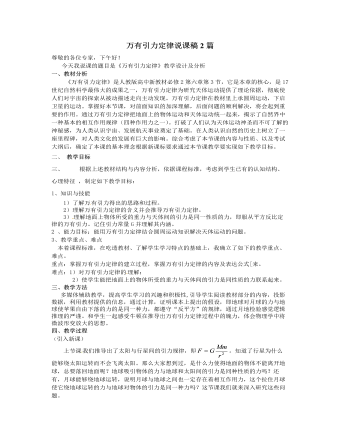
人教版新课标高中物理必修2万有引力定律说课稿2篇
学生中存在这样的问题:既然宇宙间的一切物体都是相互吸引的,那么为什么没有吸引到一起?为了解决这个问题,安排了例题2例2、两物体质量都是1kg,相距1m,它们间的万有引力是多少?通过本题,让学生认识到一般物体间的引力极小,不用考虑。那么,质量很大的天体为什么没被吸引到一块?从而引出下节课题。4.课堂小结:本节课,从天体运动出发,通过推理证明,形成理性认识,再结合例题习题使学生的理性认识再反馈到具体事实。形成实践-理论-实践的认知循环,顺应了认知规律.。本共设计了很多问,能让学生想的尽量让学生想、能学生说的尽量让学生说、能让学生做的尽量让学生做,全面发展学生的各方面能力。再通过作业和探究性课题使学生的思维活动在时空上得以延续。5.布置作业:布置作业时刻意安排引入:万有引力、重力、向心力、三者的联系,通过引导学生对比结果,从中发现问题:万有引力与重力向心力的关系与区别,为下节知识的难点突破作好了铺垫。
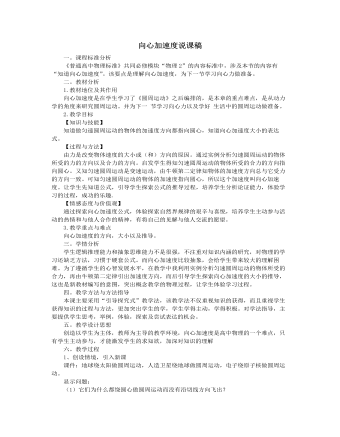
人教版新课标高中物理必修2向心加速度说课稿
d.某物体沿直线向东运动,原来的速度是5m/s,2s后速度减小到3m/s,求2s内物体速度变化。④如何探究物体作匀速圆周运动时,在Δt时间内的速度变化?分析:有了同一直线上速度变化的铺垫后,讨论物体做匀速圆周运动速度的变化就比较自然了,为了给向心加速度方向的学习打好基础,可以通过小组协作,进一步完成下列思考题,使同学们认识到:时间间隔起短,速度变化的方向起接近半径方向。(多媒体屏幕投影)a.物体沿半径为1m的轨道做匀速圆周运动,线速度大小为,求1s内物体速度变化并画出1s内速度变化的示意图。b.分别求出上题中物体在0.5s、0.25s内速度变化并画出相应的示意图。由于没有办法直接利用实验来验证速度变化的方向,所以,我们采用提供思考题的方法,引导同学在合作学习、自主探究中完成。有了速度变化的研究为铺垫,加速度的方向问题就迎刃而解了。
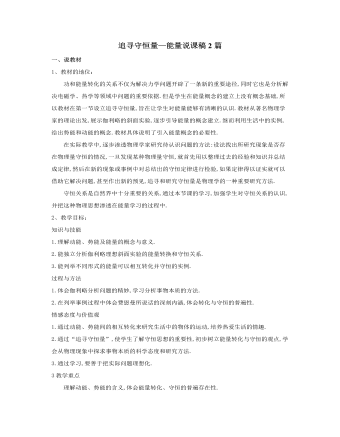
人教版新课标高中物理必修2追寻守恒量—能量说课稿2篇
[小结]师:下面同学们概括总结本节所学的内容。请一个同学到黑板上总结,其他同学在笔记本上总结,然后请同学评价黑板上的小结内容。 (学生认真总结概括本节内容,并把自己这节课的体会写下来、比较黑板上的小结和自己的小结,看谁的更好,好在什么地方。) 生:本节课我们通过伽利略理想斜面实验,分析得出了能量以及动能和势能的概念,从能量的相互转化角度认识到,在动能和势能的相互转化过程中,能的总量保持不变,即能量是守恒的。通过这节课的学习,使我们建立起了守恒的思想。 点评:总结课堂内容,培养学生概括总结能力。 教师要放开,让学生自己总结所学内容,允许内容的顺序不同,从而构建他们自己的知识框架。[布置作业]课后讨论 P3“问题与练习”中的问题。[课外训练]以竖直上抛的小球为例说明小球的势能和动能的转化情况。在这个例子中是否存在着能的总量保持不变?
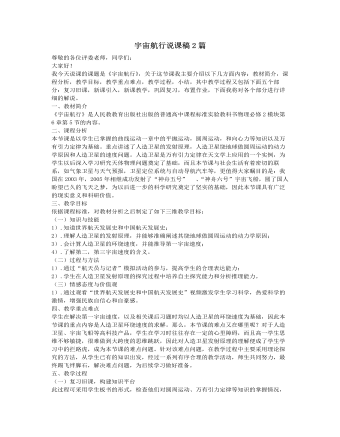
人教版新课标高中物理必修2宇宙航行说课稿2篇
了解了第一宇宙速度及其意义之后,继续提出问题,让学生思考:如果卫星的发射速度大于第一宇宙速度7.9km/s ,会出现什么情况呢?先让学生们大胆猜想,然后再向学生们介绍 卫星发射速度大于第一宇宙速度后的几种可能情况,引出第二宇宙速度和第三宇宙速度,让学生对第二、第三宇宙速度及其意义做定性了解。并通过演示Flash课件,帮助学生理解、加深学生印象。在学生对人造卫星的原理及发射卫星的速度条件有了初步了解后,接下来引导学生对卫星的运动规律作进一步的探索。实际上卫星并不是沿地表水平发射的,而是用火箭多次加速送到一定的高度的轨道后,再沿以地心为圆心的圆周的切线运行的。让学生继续深入思考:卫星在不同高度绕地球运行时的速度怎么求呢?将卫星送入低轨道和高轨道所需的速度都一样么?如果把不同轨道上的卫星绕地球的运动都看成是匀速圆周运动,引导学生利用已学的万有引力和圆周运动的相关知识,探究卫星绕地球的运行规律。
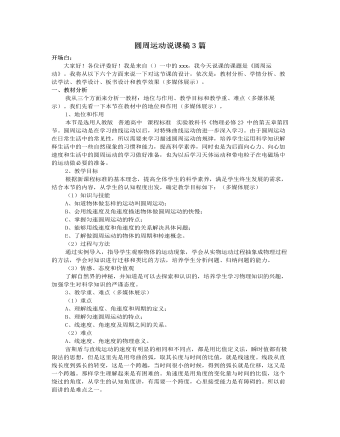
人教版新课标高中物理必修2圆周运动说课稿3篇
设计意图:通过设疑、讨论及学生的亲身体验与教师的引导,得到描述圆周运动快慢的两个物理量,也就成功的打破了学生在认识上的思维障碍,突破了物理概念教学的难点。在解决线速度和角速度的问题之后,我将引领学生学习匀速圆周运动的概念以及匀速圆周运动中线速度、角速度的特点。并引出匀速圆周运动中周期、转速的知识。为了加深学生对线速度、角速度与半径关系的认识,我设计了第三个学生体验活动:四名学生以我为圆心做圆周运动,四名学生始终并列,这时里圈同学走动不急不慢,而外圈同学则要小跑。通过学生的活动,不难发现在角速度相同的情况下,半径越大的线速度也越大。定性的得到了线速度、角速度与半径的关系。接下来让学生利用所学知识推导线速度、角速度与半径的关系。设计意图:这样就通过设疑、学生猜想、体验、推导的方式得到了结论,突破了本节课的难点即线速度、角速度与半径的关系。
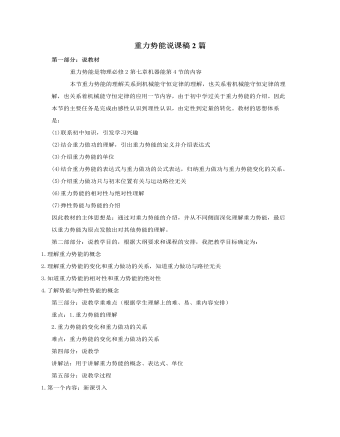
人教版新课标高中物理必修2重力势能说课稿2篇
(四)、弹性势能(据课时情况,可以让学生自学)生活中还有一些物体既没有运动也没有很大的高度却同样“储存”着能量,哪怕它只是孩童手里的玩具(图片:弹弓)。张紧的弓一撒手就会对箭支做功改变它的动能,松弛的弓有这样的本领吗?同样是弓前者具有能量而后者没有,那么什么情况下物体才具有这种能量呢?张紧的弓在恢复原状的过程会对外做功,但是拉断的弓还能有做功的本领吗?1.定义:物体由于发生弹性形变而具有的能量叫做弹性势能。2.弹性势能的大小与哪些因素有关呢?3、势能由相互作用的物体的相对位置决定的能量。重力势能:由地球和物体间相对位置决定。弹性势能:由发生形变的各部分的相对位置决定。(五).反馈练习1. 物体在运动过程中,克服重力做功50J, 则( )A.重力做功为50JB.物体的重力势能一定增加50JC.物体的重力势能一定减少50JD.重力做功为-50J

新人教版高中英语必修3Unit 1 Festivals and celebrations-Discovering Useful Structure教学设计
4.That was an experience that frightened everyone. →That was _____________________. 答案:1. taking 2. being discussed 3. in the reading room 4. a frightening experienceStep 6 The meaning and function of V-ing as the predicative动词-ing形式作表语,它通常位于系动词后面,用以说明主语“是什么”或“怎么样”一种表示主语的特质、特征和状态, 其作用相当于形容词; 另一种具体说明主语的内容, 即主语等同于表语, 两者可互换。The music they are playing sounds so exciting. 他们演奏的音乐听起来令人激动。The result is disappointing. 结果令人失望。Our job is playing all kinds of music. 我们的工作就是演奏各种音乐。Seeing is believing. 眼见为实。Step 7 Practice1. It is ________(amaze) that the boy is able to solve the problem so quickly.2. Buying a car is simply _______(waste) money. 3. Please stop making the noise—it’s getting ________(annoy). 4. complete the passage with the appropriate -ing form.La Tomatina is a festival that takes place in the Spanish town Bunol every August. I think many food festivals are __________ because people are just eating. however, this festival is _________ because people don't actually eat the tomatoes. Instead, they throw them at each other! the number of people ________ part in this tomato fight, can reach up to 20,000, and it is a very __________ fight that lasts for a whole hour. The _______ thing is how clean Bunol is after the tomatoes are washed away after the fight. this is because the juice form tomatoes is really good for making surfaces clean!答案:1. amazing 2. wasting 3. annoying4. boring interesting taking exciting amazing

新人教版高中英语必修3Unit 1 Festivals and Celebrations-Reading for Writing教学设计一
The topic of this part is “Write about your festival experience”.During the Listening and Speaking and Talking, students are just asked to say out their festival experiences such as the Spring Festival, Mid-autumn Day, but this part students will be asked to write down their own festival experiences. During the reading part, it introduces the Naadam Festival in Inner Mongolia Autonomous Region, which can give students a good example to imitate. Students not only learn the festival, but touch and feel the Inner Mongolian’s character, the spirit and cultural atmosphere, which can help students form the cultural awareness and learn to enjoy and value the diversity of Chinese culture.Concretely, the dairy tells the experience that the author spent the Naadam Festival in Inner Mongolia Autonomous Region with his/her friend. The structure is clear. In the opening paragraph, it introduces the topic of the Naadam Festival and the whole feeling. Then it introduces the items of the festival like the ceremony, wrestling and horse racing. Finally, it summarizes this experience. Because this part is a travel journal, we must guide students pay more attention to these details: 1. use the first person. 2. use the past tense to tell the past thing and use the present or future tense to describe the scenery. 3. use the timeline to tell the development. 4. be careful for the author’s psychology, emotion and feeling, etc.1. Read quickly to get main idea; read carefully to get the detailed information about Naadam Festival.2. Learn the structure of the reading article and language.3. Write an article about a festival experience4. Learn to use the psychology, emotions and feeling in the writing.1. Write an article about a festival experience.2. Use the structure of the reading article and language.
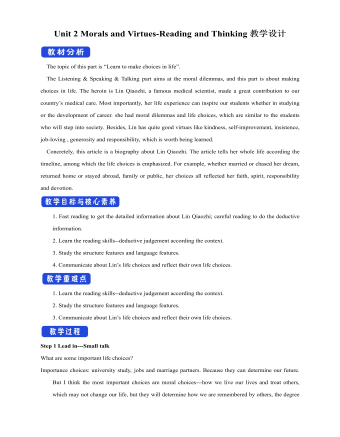
新人教版高中英语必修3Unit 2 Morals and Virtues-Reading and Thinking教学设计
The topic of this part is “Learn to make choices in life”.The Listening & Speaking & Talking part aims at the moral dilemmas, and this part is about making choices in life. The heroin is Lin Qiaozhi, a famous medical scientist, made a great contribution to our country’s medical care. Most importantly, her life experience can inspire our students whether in studying or the development of career. she had moral dilemmas and life choices, which are similar to the students who will step into society. Besides, Lin has quite good virtues like kindness, self-improvement, insistence, job-loving , generosity and responsibility, which is worth being learned.Concretely, this article is a biography about Lin Qiaozhi. The article tells her whole life according the timeline, among which the life choices is emphasized. For example, whether married or chased her dream, returned home or stayed abroad, family or public, her choices all reflected her faith, spirit, responsibility and devotion.1. Fast reading to get the detailed information about Lin Qiaozhi; careful reading to do the deductive information.2. Learn the reading skills--deductive judgement according the context.3. Study the structure features and language features. 4. Communicate about Lin’s life choices and reflect their own life choices.1. Learn the reading skills--deductive judgement according the context.2. Study the structure features and language features.3. Communicate about Lin’s life choices and reflect their own life choices.Step 1 Lead in---Small talkWhat are some important life choices?Importance choices: university study, jobs and marriage partners. Because they can determine our future.

新人教版高中英语必修3Unit 3 Diverse Cultures-Discovering Useful Structure教学设计
Step 4 PracticeRead the conversation. Find out which words have been left out.Justin: Linlin, I’m going to Guizhou Province next month. I’m super excited! Any recommendations for places to visit?Linlin: Wow, cool! Guizhou is a province with a lot of cultural diversity. Places to visit...well, definitely the Huangguoshu Waterfall first.Justin: What’s special about the waterfall?Linlin: Well, have you ever heard of the Chinese novel Journey to the West ?Justin: Yes, I have. Why ?Linlin: In the back of the waterfall, you will find a cave, which is the home of the Monkey King.Justin: Really? Cool! I’ll definitely check it out.Linlin:And I strongly recommend the ethnic minority villages. You’ll find Chinese culture is much more diverse than you thought.Justin:Sounds great, thanks.Answers:Justin: Linlin, I’m going to Guizhou Province next month. I’m super excited! Do you have any recommendations for places to visit?Linlin: Wow, that’s cool! Guizhou is a province with a lot of cultural diversity. What are some places to visit in Guizhou ? Well, definitely the Huangguoshu Waterfall is the first place to visit in Guizhou Province.Justin: What’s special about the waterfall?Linlin: Well, have you ever heard of the Chinese novel Journey to the West ?Justin: Yes, I have heard of the Chinese novel Journey to the West . Why do you ask if I have heard of the Chinese novel Journey to the West?Linlin: In the back of the waterfall, you will find a cave, which is the home of the Monkey King from Journey to the West.Justin: That’s really true? It’s Cool! I’ll definitely check it out.Linlin:And I strongly recommend the ethnic minority villages on your trip to Guizhou Province. You’ll find Chinese culture is much more diverse than you thought it was.Justin:This all sounds great, thanks.
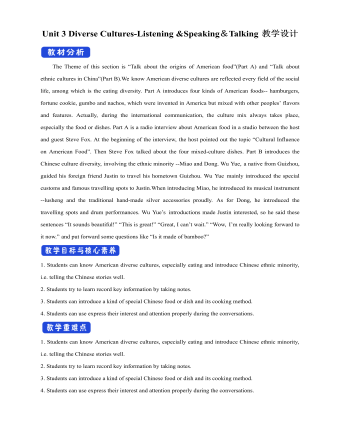
新人教版高中英语必修3Unit 3 Diverse Cultures-Listening &Speaking&Talking教学设计
1. In Picture 1 and Picture 2, where do you think they are from? How do you know?From their wearings, we can know they are from ethnic minority of China--- Miao and Dong.Picture 1, they are playing their traditional instrument lusheng in their traditional costumes.Picture 2. the girls are Miao because they wear their traditional costumes and silver accessory.2. In Picture 3, can you find which village it is? What time is it in the picture?It is Dong village. It is at night. Step 2 While-listeningJustin met a new friend while traveling in Guizhou. Listen to their conversation and complete the summaries below.Part 1Justin and Wu Yue watched some Miao people play the lusheng. The instrument has a history of over 3,000 years and it is even mentioned in the oldest collection of Chinese poetry. Then they watched the lusheng dance. Justin wanted to buy some hand-made silver/traditional accessories as souvenirs. He was told that the price will depend on the percentage of silver. Part 2They will go to a pretty Dong minority village called Zhaoxing. they will see the drum towers and the wind and rain bridges. They may also see a performance of the Grand Song of the Dong people.Step 3 Post-listening---TalkingWork in groups. Imagine Justin is telling some friends about his trip to Guizhou. One of you is Justin and the rest of you are his friends. Ask Justin questions about his trip and experience. The following expressions may help you.
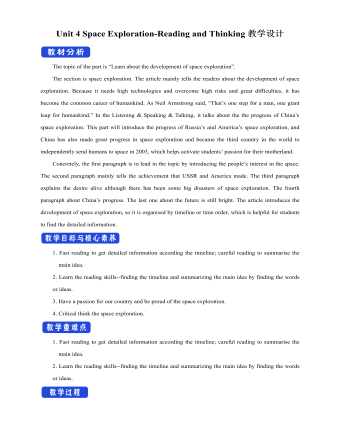
新人教版高中英语必修3Unit 4 Space Exploration-Reading and Thinking教学设计一
Q4: What is the function of the International exploration ?Having astronauts from different countries on boardQ5: What can you learn from Para 4 ?China has made great achievements in exploring spaceQ6: What is the attitude to the space exploration ?SupportiveStep 6 Post reading---RetellPeople have always wanted to learn more about space. Before the mid-20th century, most people felt (1)_________ (travel) into space was an impossible dream. However, (2)____ the help of scientists, peoplesucceeded in realizing their dream (3) _________ (explore) space. On 4 October 1957, the Sputnik 1 satellite (4) ____________(launch) by the USSR. (5) ________________ scientists try to make sure nothing goes wrong, accidents can still happen. These disasters made everyone(6)___________(disappoint), but people still believe in the importance of (7) ________(carry) on space exploration. In 2003, China became the third country to (8)_____________ (independent) send humans into space. Then Shenzhou 6 and 7 completed (9)____ second manned orbit and the first Chinese spacewalk. In spite of the difficulties, scientists hope future (10)__________ (discovery) will not only enable us to understand the universe but also help us survive well into the future.Answers: 1. travelling 2. with 3. to explore 4. was launched 5. Although6. disappointed 7. carrying 8. independently 9. a 10. discoveriesStep 6 Post reading---Critical thinkingQ1: What do you think of the space exploration ? I think it is beneficial to us. Through further study of space, people will make full use of it in the future, such as the space experiments by Wang Yaping in Tian Gong 1.Q2: If you are determined to be an astronaut, what should you prepare at present ?First of all, I should study hard to get a related college degree. Besides, I must keep mental and physical healthy.Step 7. HomeworkTry to summarize the structure of the article by a mind map.
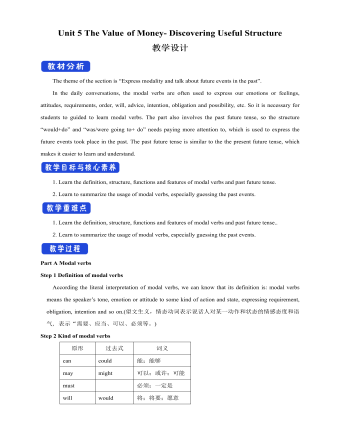
新人教版高中英语必修3Unit 5 The Value of Money- Discovering Useful Structure教学设计
Step 3 Meaning1. 过去将来时表示从过去某一时间来看将要发生的动作或存在的状态, 常用在宾语从句中。一般由“would/should +动词原形”构成。She hoped that they would meet again someday. 她希望将来有一天他们能再见面。2. was/were going to+动词原形: 表示过去将要发生或很有可能发生的动作, 常用于口语中, 表示预言、意图或者打算等。He was going to start work the following week. 他打算下星期开始工作。3. was/were about to do: 常用来表示即将发生的动作, “刚要/正要做……”。注意该结构不与任何时间状语连用。I felt that something terrible was about to happen. 我感到某种可怕的事情即将发生。4.was/were to do: 表示“曾计划做某事”, 如果表示“本来计划做某事, 动作没实现”, 则需用 “was/were to have done”。She said she was to have told me about the accident. 她说她本来想告诉我关于事故的事。5.Start, go, come, leave, see, meet等动词的过去进行时: 表示就过去某一时刻而言即将发生的动作。She was coming later. 她随后就来。I had just put on my overcoat and was leaving to visit a friend of mine. 我刚穿上外套要去看我的一个朋友。

新人教版高中英语必修3Unit 5 The value of money-Reading and Thinking教学设计二
? Could you offer me some kind of work here?? I don’t want your charity, I just want an honest job.? Careless: I landed in Britain by accident.Step 7:Consolidation.? Find Henry? Roderick and Oliver were I .making a bet when they saw Henry, a poor young man. ? Know Henry? About a month ago, Henry was sailing and later he found himself carried out to sea by a strong wind. Fortunately, he 2.was spotted by a ship. And it was the ship that brought him to 3.England? Offer money to Henry ? Oliver and Roderick gave Henry a letter and told him that there was money in it. They 4.persuaded him to accept it, and made him 5.promise that it wouldn't be opened until 2 o'clock.Step 8:Language pointsa large amount of: a large quantity of; a great deal ofe.g. They bought a large amount of furniture before they moved their new house.make a bet: make an arrangement to risk money, etc. on an event of which the result is doubtful.e.g. We made a bet on the result of the match.permit sb to do something: allow somebody to do somethinge.g. My mother doesn’t permit me to ride in the street after it rained.by accident: as a result of chancee.g. I only found it by accident.stare at: look at somebody or something with the eyes wide open in a fixed gaze( in astonishment, wonder, fear, etc)to be honest: to tell you the truth; to be franke.g. To be honest, I don’t think we have a chance of winning.Step7 Homework:What do you think will happen to Henry? Will the bank-note help him or get him into trouble?
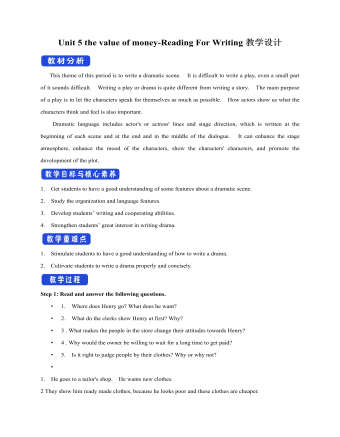
新人教版高中英语必修3Unit 5 the value of money-Reading For Writing教学设计一
【参考范文】Narrator:(Henry is smiling as he leaves the restaurant. As he is walking down the street, he sees a sign for a place that cuts hair. He decides to get it cut. )H=Henry;B=Barber;R=rude manH:Good afternoon, I'd like to get a cut, if I may. (The barber looks at Henry's hair and continues cutting another man's hair. )Er, I'd really like a haircut. As you can see it's much too long. B:(in a rude manner) Yes, I can see that. Indeed, I can. H:Fine, well I'll have a seat then. (He sits in one of the barber's chairs. The barber turns to look at Henry. )B:It's quite expensive here, you know!Are you sure you can afford it?H:Yes. I think so. (In comes the rude man. )R:Hey you there. I need a haircut quickly. Can you do me straightaway?B:All right, then, get in the chair and I'll see what I can do. R:Thank you. (sits down in one of the barber's chairs)H:Excuse me, but I was here first. Aren't you going to do my hair first?B:This man's in a hurry. H:Well so am I!I insist that you cut my hair first. B:OK, but I'll have to be quick. This gentleman is waiting. H:Thank you. (They both become quiet. After his hair is cut, the barber tells Henry how much he must pay. Henry shows the barber the bank note. )B:Why, Mr . . . (looks shocked)H:Adams. Henry Adams. I'm sorry, I don't have any change. R:You're that Mr Adams! Well,I'm glad I waited or I might never have known it was you. B:Why, Mr Adams, please don't worry!(wearing a big smile) Nothing to worry about!Nothing at all!Please come back any time, even if you only need too little hairs cut!It will be my honour to serve you!